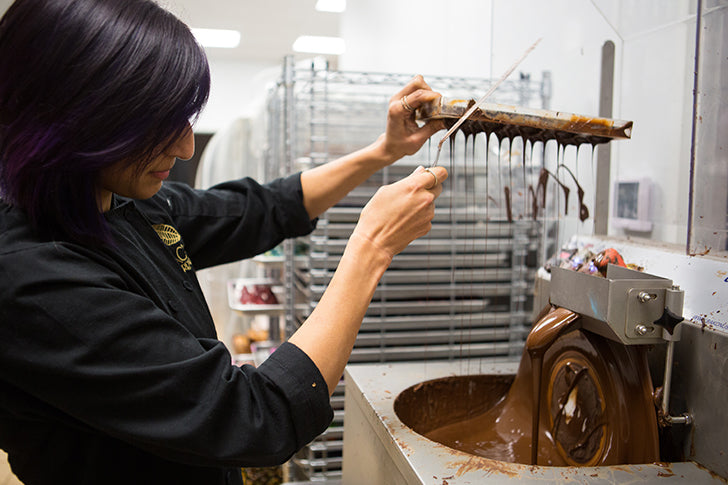Best Gourmet Chocolates

The Chocolate Making Process from Bean to bar.
Chocolate is one of the world’s most cherished delights, loved by millions for its rich taste, smooth texture, and ability to bring joy. But behind every piece of chocolate is a fascinating and meticulous process that turns cacao beans into the decadent treats we know and love. At Cacao and Cardamom, we take pride in crafting exquisite gourmet chocolates, especially our signature gourmet milk chocolate, using traditional methods that highlight the true essence of cacao. Let’s take a deep dive into the journey of chocolate making, from bean to bar.
1. Sourcing Cacao Beans
The journey of chocolate making begins with the cacao tree, known scientifically as Theobroma cacao. These trees thrive in tropical climates near the equator, with regions in West Africa, Central and South America, and Southeast Asia being the primary sources of cacao beans.
At Cacao and Cardamom, we are committed to sourcing only the highest quality beans, often from single-origin farms, to ensure that the unique flavors of the cacao are preserved. Each region's beans carry distinct flavor profiles influenced by the soil, climate, and cultivation methods, contributing to the rich diversity found in gourmet chocolates.
2. Harvesting and Fermentation
Once the cacao pods ripen, they are harvested by hand. Inside these pods are cacao beans surrounded by a sweet, white pulp. The beans are removed and left to ferment for several days. This fermentation process is crucial in developing the complex flavors of the chocolate. Without it, the beans would lack the depth of taste that defines fine chocolates.
Fermentation triggers chemical reactions that reduce the beans' bitterness, enhance their flavor, and prepare them for the next step in the process. The length and method of fermentation can significantly impact the final taste, and this is where the artisan chocolatier’s expertise comes into play.
3. Drying and Roasting
After fermentation, the beans are spread out to dry under the sun for several days. This drying process reduces the moisture content and further refines the beans' flavor. Once dried, the beans are shipped to chocolate makers around the world, including our artisan workshop at Cacao and Cardamom.
The next step is roasting, which is where the magic of chocolate making truly begins. Roasting the cacao beans enhances their flavor and gives them the rich, chocolatey taste we all recognize. The temperature and duration of the roast are crucial, and artisanal chocolate makers like us at Cacao and Cardamom adjust these factors to achieve the perfect balance of flavors for each type of bean. For our gourmet milk chocolate, we take great care to bring out a harmonious blend of sweetness and depth.
4. Cracking and Winnowing
Once roasted, the beans need to be cracked open to separate the nibs from the shells. The cacao nibs are the edible part of the bean and are full of rich flavors and nutrients. This process, known as winnowing, removes the unwanted outer shell, leaving behind the pure nibs that will be transformed into chocolate.
5. Grinding and Conching
The nibs are then ground into a thick paste known as chocolate liquor. Despite the name, chocolate liquor contains no alcohol; it is simply a combination of cocoa solids and cocoa butter. During the grinding process, heat is generated, causing the cocoa butter to melt and blend with the solids, creating a smooth mixture.
At this stage, sugar, milk powder (for milk chocolate), and other ingredients are added. The mixture then goes through a process called conching, where it is continuously stirred and aerated to further develop the flavor and texture. This step can last anywhere from several hours to multiple days, depending on the desired outcome.
Conching smooths out the chocolate and helps remove any remaining bitter or sour notes, resulting in a rich and velvety texture. For our gourmet milk chocolate, this step is essential to achieve the creamy, luxurious mouthfeel that sets our chocolate apart.
6. Tempering and Molding
After conching, the chocolate is tempered. This is one of the most critical steps in chocolate making, as it involves carefully cooling and reheating the chocolate to stabilize the cocoa butter crystals. Proper tempering ensures that the chocolate has a glossy finish and a satisfying snap when you break it.
Once tempered, the chocolate is poured into molds to create bars, truffles, or other gourmet chocolates. At Cacao and Cardamom, we also add unique flavors and ingredients to our chocolates at this stage, crafting beautiful and delicious creations that reflect our commitment to quality and innovation.
7. Packaging and Presentation
The final step in the chocolate-making journey is packaging. Presentation plays a significant role in the gourmet chocolate experience, and we take great care in designing elegant, artistic packaging that complements the luxurious nature of our products. Our chocolate boxes are not only a feast for the taste buds but also for the eyes, making them the perfect gift for any occasion.
The journey of chocolate making is a labor of love, requiring skill, patience, and a deep respect for the craft. From the careful selection of cacao beans to the final molding and packaging, each step is essential in creating the gourmet chocolates you enjoy. At Cacao and Cardamom, we take pride in preserving the traditional methods of chocolate making while infusing our creations with innovative flavors and presentations.
Whether you savor the rich complexity of dark chocolate or the creamy indulgence of our gourmet milk chocolate, each bite tells the story of its meticulous journey from bean to bar. We invite you to explore the world of fine chocolate with us and indulge in the artistry that goes into every piece.
How Chocolate is Made: The Journey of Chocolate Making
By Sandeep Pamnani
In Chocolate making, Gourmet chocolates, Gourmet milk chocolate









